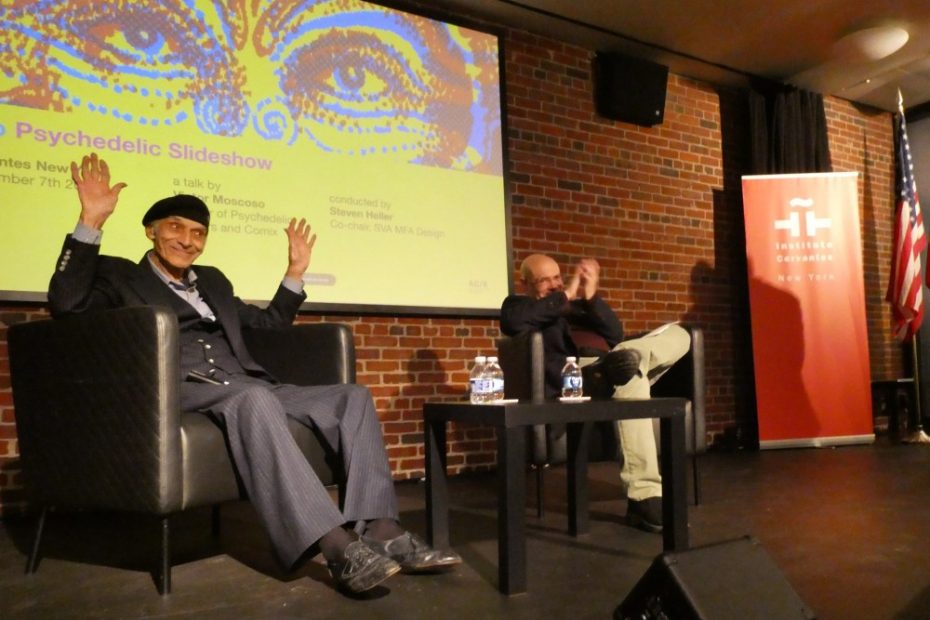Last week the Instituto Cervantes welcomed guests to see Moscoso Cosmos—the first time in decades that Victor Moscoso’s luminous poster and surreal underground comics have been featured in a solo exhibition (which was brilliantly curated by David Carbalall). Prior to opening the gallery, Moscoso sat down with me in the Cervantes auditorium to regale the audience with memories, anecdotes and history. At 87, the guy is an incredible wealth of insight (and sunlight). This was his only speaking gig in New York City, and if you missed it, you can see it here. You can find the bilingual catalog here.
The following is my introduction before Moscoso took the microphone.
Photos courtesy David Caraball
Some of you may be here to indulge in a little hallucinogenic flashback. Others are here to celebrate an iconic artist who helped define the modern aesthetic of his era just as A.M. Cassandre did for his. He is an artist whose drawings are as fluid and witty as the great cartoon and comic artists of the gilded age. Victor Moscoso’s work tends to be locked into a tight timeframe, while in fact his art is open to appreciation by all generations because its craft, innovation and response to social and cultural prompts of his time.
I’ve come here tonight not to relive my counterculture moments—which I don’t recall anyway—but to experience a great artist’s incomparable work as abstract storyteller, inventive typographer and daring colorist.
Victor Moscoso was chief among the tribe of graphic maestros and principal form-givers of the ’60s, and this continues into the 2020s. He lived through the ’60s and is still able to remember it. The Spanish-born, Brooklyn-raised, Yale-educated artist stumbled into the counter culture and arose to become the genius of a distinct American music-inspired graphic poster language.
Although the movement’s name was not coined by any of the artists, psychedelic aptly underscored the hypnotic letterforms and vibrating color combinations and retro-fitted antique illustrations. They used their visual language as a code that vividly communicated to those visionary—or stoned—enough to see the messages through the chromatic haze. While many of the artists who were making cheaply printed flyers promoting ballroom concerts were ostensibly self-taught, their respective work unwittingly redefined a large swath of commercial art, graphic design and fine arts too (even today).
Moscoso was unique in ways that gave him anomaly status among his peers. He was the only formally art school and university–trained artist in this otherwise grassroots poster movement. He really knew how to draw in a classical sense and understood design theory. He had studied Bauhaus history and early and midcentury Modernism. In short, Moscoso had bona fides as a Modernist. But his tenure at New York’s Cooper Union and later Yale—where he was taught by none other than the renowned color master and Bauhausler Josef Albers—was not so much an advantage as a handicap; to work in his newfound counter-culture genre he had to reverse everything he learned.
